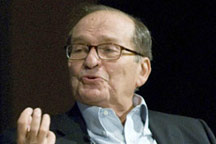 In February 2008, NYC’s Film Forum held a tribute to director Sidney Lumet, who died today at the age of 86. The celebration of Lumet’s life and career took the form of a two-hour Q&A, interspersed with clips from some of his most memorable films. We were lucky enough to be on hand, and we are pleased to offer, as a tribute to a very talented movie maker, our account of the evening.
In February 2008, NYC’s Film Forum held a tribute to director Sidney Lumet, who died today at the age of 86. The celebration of Lumet’s life and career took the form of a two-hour Q&A, interspersed with clips from some of his most memorable films. We were lucky enough to be on hand, and we are pleased to offer, as a tribute to a very talented movie maker, our account of the evening.
Lumet shared in the early part of the discussion that his father, Baruch, was an actor in the Yiddish theatre, and Sidney himself got his start there at a very early age.
Lumet went on to appear in a number of Broadway shows, among them a Max Reinhardt production, before slipping behind the camera as a television director in the 1950s.
So it was fitting that the evening opened with a clip from One Third of a Nation (1939), which boasts Lumet’s only film acting appearance. The then-14-year-old director-to-be starred as the nephew of Sylvia Sidney.
The next clip shown was from the first movie he directed, Twelve Angry Men (1957). Asked if he’d made a specific effort to make the film in a cinematic style, so as to prove to the industry bigwigs that he could direct as well for the large screen as for the small, Lumet admitted with a laugh, “I was too arrogant. It never occurred to me that I might need to convince anyone.”
Asked later about working with Henry Fonda, Lumet said Fonda was constitutionally unable to make a false or dishonest move as an actor. “I don’t think he could’ve done it if I’d asked him to,” Lumet said. “He could only play the truth.”
Lumet said that filming on Twelve Angry Men was completed in 19 days. He said he shot the film in a very particular way. There were three levels of lighting in the film—sunlight through the windows, cloudy skies, as a storm approached outside, and with the overhead lighting in the jury room illuminated once the storm is underway.
Lumet shot the film entirely out of sequence, rotating around the room, getting each shot he needed from each actor under that particular lighting. Once he’d shot all of his sunlit shots, Lumet had the set relit to suggest cloudy conditions and slowly worked his way around the room again, going from character to character, getting every shot he needed.
Finally, he had the set relit once last time, with overhead lighting lit, and made the rounds again.
Lumet said he never used storyboards, as Alfred Hitchcock was famous for doing. Instead, he preferred to rehearse his actors for two weeks, as if they were mounting a play, and when he had all the blocking down, then he considered where to place the camera in each scene.
Read More »
